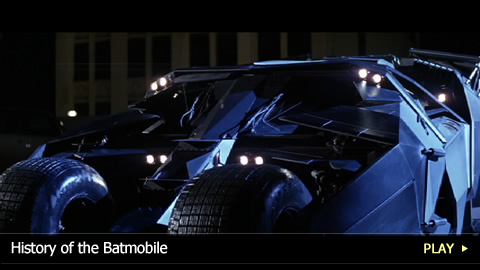History of the Batmobile

advertisement
VOICE OVER: David
It's the Dark Knight's preferred method of transportation. Debuting in 1941's Detective Comics #48, Batman's car quickly became his greatest tool for crime fighting. Originally lacking a name, or any semblance to what it is today, it was bright red, and lacked fins or shields. In fact, it was devoid of the signature “bat” theme, with the small exception of a gold hood ornament. Following its initial appearance, Batman's ride was overhauled when it appeared in Batman issue #5. Over the course of 70 years, the Batmobile has changed countless times; and will continue to change as long as there are Batman comics, films and merchandise. Join http://www.WatchMojo.com as we take a look at the history and evolution of the Batmobile.
History of The Batmobile
It’s the Dark Knight’s preferred method of transportation. Welcome to WatchMojo.com, and today we’ll be taking a look at the evolution of the Batmobile.
Debuting in 1941’s Detective Comics #48, Batman’s car quickly became his greatest tool for crime fighting.
Originally lacking a name, or any semblance to what it is today, it was bright red, and lacked fins or shields. In fact, it was devoid of the signature “bat” theme, with the small exception of a gold hood ornament. In its place it had a supercharged engine, and heavily re-enforced nose capable of smashing through obstacles.
Following its initial appearance, Batman’s ride was overhauled several months later when it appeared in Batman issue #5. Officially taking form as the “Batmobile”, it was now given a proper look. Re-imagined in black, it became equipped with fender skirts to protect the tires, armored panels, a fin, and even a bat-head shaped battering ram.
Despite the major leap in design, it would continue to be re-invented regularly due to different artists adding their own interpretations of what the car should be. These changes included shifting its size, shape, and features, while adopting futuristic concepts, such as that of a bubble dome.
Despite the thrilling changes going on in the comics, 1943’s live-action Batman serial did away with any sense of style. This was due to the program’s low budget, which could only afford its producers to acquire a Black Cadillac, which came to be used by both Bruce Wayne and Batman.
In 1964, Batman’s car was revamped to become a sportier two seat Roadster. This in turn led to the design of the 1966 Television series version, which was equipped with Ford’s abandoned Futura concept car. This became the first full size, fully operational Batmobile, and was chosen for its ability to easily showcase the dynamic duo. Due to the show’s success, this vehicle instantly became one of the most famous in the world.
A few years later, the design of the car was modified for the Superfriends cartoon series, with the unique considerations of making a car that could be easily redrawn repeatedly for the animation.
Then, after nearly three decades, Batman returned to live action in 1989 with Tim Burton’s “Batman.” Thanks to a darker take on the caped crusader, it was unlike any previous incarnation. With a custom-built body, it added a front jet turbine intake, rear after-burner, side fins, two-seat cockpit with aircraft-like instrumentation, a heavy metal armor cocoon, and an array of weaponry. These included spherical bombs, a pair of machine guns and grappling hook launchers. Insanely popular, it rivaled the attention given to the previous live-action Batmobile, and became the main influence on the design of its counter-part in “Batman: The Animated Series.”
Of course, for marketing purposes, the Batmobile was completely redesigned twice for Joel Schumacher’s films “Batman Forever” and “Batman & Robin.” The first was based off of an organic aesthetic that mirrored a body’s use of ribs and lungs. The second version features an older roadster design that stretched out over 30 feet long and could only seat one.
Continuing to change dramatically from one comic book series to the next, it was finally remade for the big screen when the caped crusader returned for 2005’s “Batman Begins.” In this series reboot, it was given a function over style consideration, capable of making large jumps and forming an escape motorcycle form from its front wheels.
Over the course of 70 years, the “Batmobile” has changed countless times for the comics, television shows and films; and will continue to change as long as there are Batman comics, films and merchandise.

